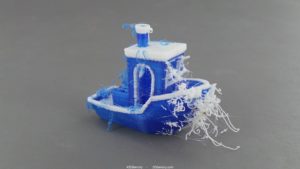
Boats everywhere! Very exciting, especially if you’re Becky from How I Met Your Mother (…or a 3D printing enthusiast) [gif via Imgur]
The Benchy provides a critical benchmarking capability for use in calibrating, testing, and comparing 3D printers; can a 3D printer successfully create overhangs, fine angles, and holes? Are settings proper for a given material? Check it by 3D printing a Benchy.
The Creative Tools team carefully designed a clever model that can bring many of the key benchmarking elements into one quick build. Sitting down recently for coffee in Birmingham with prolific designer and open source proponent Daniel Norée afforded me the unique opportunity to gain his perspective. While we talked about some broader, community-level concerns, I realized I was quite curious about the origins of Benchy the benchmarking boat, as many were to be seen throughout the busy TCT Show where we sat.
- 3D Platform’s large Benchy
- Multi-colored Benchy from ZMorph [Photos from TCT Show 2017: Sarah Goehrke]
“I worked at a sheet metal fabrication company, where the boss would let us stay late and do our own work on the machines, so I learned all I could: milling, lasers – and then I got my hands on a 3D printer. It changed my life, almost,” he told me of his own origins working with additive manufacturing.
“I developed a friendship with the guy I bought the printer from, and eventually he said, ‘Why don’t you just work here?’ I had the job of finding issues with the printers, to troubleshoot and show off. That’s how 3D Benchy was born. It was originally designed for internal use, but eventually we decided to share it. We did the website, and the rest is history.”

Mid-chat selfie via Daniel Norée on Twitter
A benchmarking design is a logical step for calibration and troubleshooting, and has obviously been a favorite among makers and creators as they work with their 3D printers. But why, I asked, a boat?
“We did a tree frog like everyone else, and we wanted something similar, with organic and geometric shapes to calibrate extrusion and so on,” he said. “We looked at a house, a spaceship, and more — and we ended with a tiny boat.”
This “tiny boat” is by no means Norée’s only popular design we’ve all become familiar with over the years. The founder of OpenRC Project, he also dedicates plenty of time to drivable model cars and all the parts they encompass, along with the companion OpenRailroad Project. An aspect Norée loves best about his work with these designs is that they take on a life of their own once he releases the files into the world for open source use.
Early this year, he collected a reel of his 3D printing projects to date:
Norée came into the open source community in a similar fashion to his introduction into 3D printing, as he purchased his first Thingimatic, at which time he didn’t know about the open source world.
“I didn’t know open source existed; I knew about open source software, but not about open source 3D printing. Doing this process, building my first Thingimatic, I stumbled no this community,” he told me.
“It was an eye-opener, how nice the people were, how they were sharing files. I designed my first Open RC Car. People downloaded it, and then it all snowballed.”
As the project and the offshoot builds snowballed, he learned to love that growth from one idea to many, as part of a community.
“This is the heart of it — if you took it away, you’d lose that. All the stories people email, they’re building for their son, they’re building something new. How do you get that any other way? There is support — from companies as well as people,” Norée said. “Building on designs is a big part; people are amazingly intelligent, you can see it just browsing on Thingiverse. People are building on my designs, to float, to be a Batmobile.”
The breadth of different projects that spring from one idea, from one design, showcases the best of open source, and the aspect Norée loves so much about it. Norée noted that he enjoyed the opportunity to meet more of the community as he spent a day visiting with Ben Hawksworth and the team at the Hawk 3D Proto booth during TCT Show. Meeting in person showed Norée’s genuine and heartfelt enthusiasm for the community, which was echoed throughout the week in Birmingham through other open source celebrations, including the ‘open sauce’ dinner and RepRap founder Dr. Adrian Bowyer’s induction into the new TCT Hall of Fame.
The enthusiasm for open source — and specifically for the Benchy — continues to set fires of inspiration.
As we’ve recently been taking a look at some of the (subjectively) most important 3D printed things ever made, we opened the question to the community. Just yesterday we published the results of our admittedly informal findings, and the tallied votes didn’t show up any major surprises as innovations that spur other innovations took the top places. Coming in at the #1 most significant 3D printed thing was Dr. Bowyer’s RepRap Project — and shortly following that at #3 was the #3DBenchy.
- ‘Tis the (Benchy) season
- …unless something goes wrong
Benchy, designed to print in under two hours to show off capabilities, has indeed proven a landmark make. The milestones continue to pile up, as today, November 1, Creative Tools has announced that the #3DBenchy is the most 3D printed thing in the world.
Thingiverse provided internal statistics to Creative Tools, and they report:
“As the time of writing, the #3DBenchy file has the following metrics on Thingiverse.com.
- Likes: 14,819
- Collects: 19,702
- Comments: 222
- Makes: 2,029
- Watch: 231
- Views: 694,702
- Downloads: 345,217
A big thank you should also be directed to the team behind Thingiverse.com for providing the following detailed statistics about #3DBenchy.
- #1 overall Thingiverse stats combined
- #1 in downloads
- #1 in collections
- #1 in makes
- #4 in views
- #7 in likes
There are currently 1.5 million members and around 1.8 million designs on Thingiverse.com.”
 You can find the Thingiverse files for the Benchy — and check out the stats, some of which have already risen — here. Creative Tools has taken a dive into the history of #3DBenchy and its application as a measuring tool for 3D printing here.
You can find the Thingiverse files for the Benchy — and check out the stats, some of which have already risen — here. Creative Tools has taken a dive into the history of #3DBenchy and its application as a measuring tool for 3D printing here.
Have you 3D printed a Benchy? Discuss benchmarking and other 3D printing topics at 3DPrintBoard.com or share your thoughts in the Facebook comments below.
[Images unless otherwise credited provided by Daniel Norée / Creative Tools]
Subscribe to Our Email Newsletter
Stay up-to-date on all the latest news from the 3D printing industry and receive information and offers from third party vendors.
Print Services
Upload your 3D Models and get them printed quickly and efficiently.
You May Also Like
The Dental Additive Manufacturing Market Could Nearly Double by 2033, According to AM Research
According to an AM Research report from 2024, the medical device industry, specifically in dentistry, prosthetics, and audiology, is expected to see significant growth as these segments continue to benefit from...
Heating Up: 3D Systems’ Scott Green Discusses 3D Printing’s Potential in the Data Center Industry
The relentless rise of NVIDIA, the steadily increasing pledges of major private and public investments in national infrastructure projects around the world, and the general cultural obsession with AI have...
AM Research Webinar Explores Continuum’s Sustainable Metal Additive Manufacturing Powders
Metal additive manufacturing (AM) powder supplier Continuum Powders is working to develop solutions that empower industries to reduce waste and optimize their resources. An independent life cycle assessment (LCA) of...
3D Printed Footwear Startup Koobz Lands $7.2M in Seed Round
California-based Koobz is focused on reshoring the U.S. footwear supply chain with advanced manufacturing processes, including 3D printing. The startup just announced that it has added $6 million to its...








































